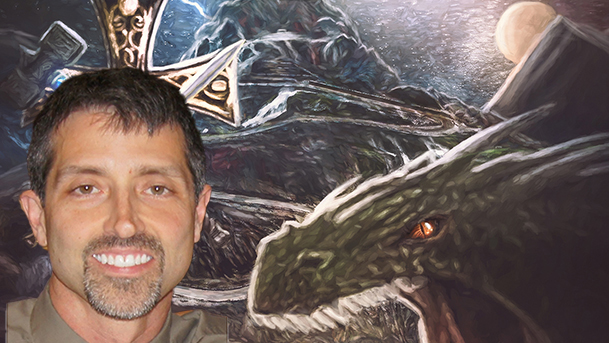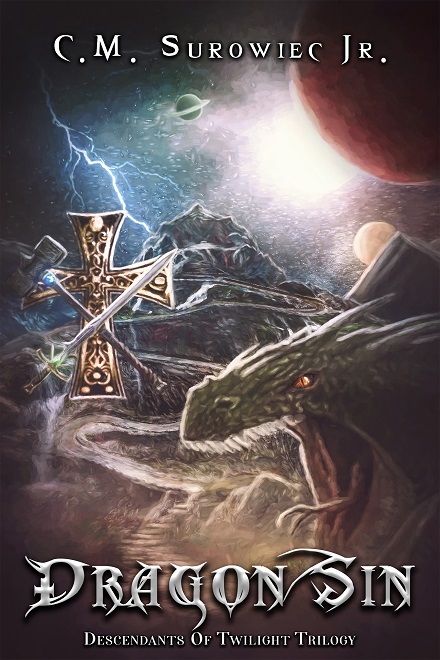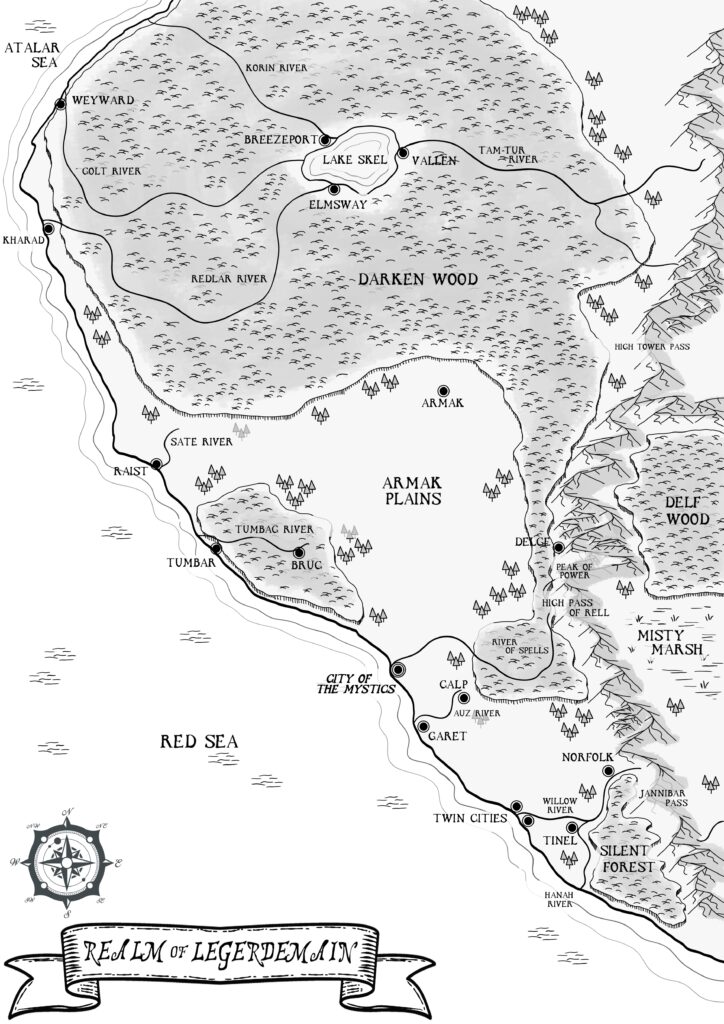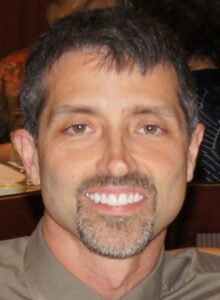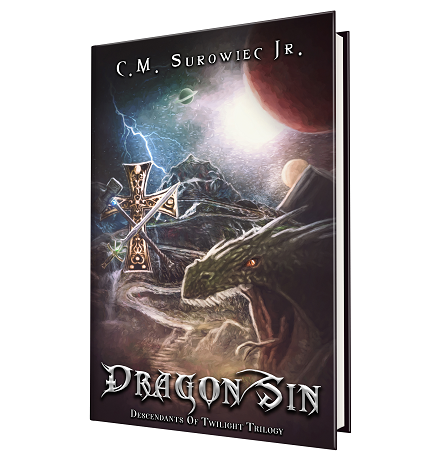Last week, Tellest had the privilege of hosting the debut fantasy of one C.M. Surowiec Jr. His world of Erogoth was exotic and interesting, and it was one of those concepts that had you hungry for more. Well, it’s time to satiate that appetite, because we have the wonderful chance to learn from its creator. Read on to learn more about C.M. Surowiec Jr.
Tellest: Hello C.M.! First off, thank you for taking some time away from all your other projects and plans to talk to me about your world and your books. With as much work as you’ve put into Erogoth, I’m certain that you must carve out what little time you have to figure out how best to market and chat with folks. I’m excited to give fantasy fans the opportunity to learn more about you and how you breathe fresh life into the genre.
C.M. Surowiec Jr.: Hello! And thank you for the intro and your kind words. I am also excited to speak with you and share more about the World of Erogoth and my new book, DragonSin.
T: My first question is one that I always like to ask about. I find that a big part of what helps a fantasy fan discover their favorite new author is figuring out a writer’s inspirations and motivations. With that in mind, what was it that appealed to you about the genre? Did you have an author you were drawn to, or did you enjoy creating stories with your friends in a way that grew and took greater shape?
CMS: I started playing Dungeons & Dragons in the seventh grade, but only after I discovered the book Sword of Shannara. Both of these were the main catalysts for my interest in the fantasy genre. Tolkien, Dragonlance, and Drizzt came much later, but helped to cement my feelings.
T: Since D&D is such a collaborative effort, it can often help to percolate ideas that storytellers might not have on their own. Did you ever hear an idea or a concept from someone else in any of your groups that you just had to run with?
CMS: When I was in eighth grade, my cousin and I tried to re-create Bilbo Baggins’s grand adventure. Unfortunately, our hobbit had several mishaps and had to be resurrected to continue his journey. It was a lot of fun! However, our interpretation of the novel (The Hobbit) was much different than the three-part movie that was released a decade ago.
T: What about when it comes to some sort of integration in your own books? Have you ever played a session where something just clicked in your head as an “aha, I’m going to use this in my literary universe” sort of moment?
CMS: I have only written one book, DragonSin, and I have not incorporated anything from a gaming session into the book that I am aware of. However, gaming groups always like to go “off-script” by exploring a part of the world or realm that is not well defined. I never try to lead them back into the staged event, and I love the opportunity to ad lib the rest of the gaming session. I take good notes and incorporate everything from the session into my world, maps, conflicts, people, etc… The funny thing is, those gaming sessions are usually a lot of fun, even though all of my prep work was for naught.
T: One of Salvatore’s Companions books pitched me down my own writing path, so it’s always nice to see another fan of Bob’s work. Which of his stories did you start with?
CMS: I have read the first nine books twice and the Dark Elf Trilogy thrice (lol) and is obviously my favorite. To answer the question though, The Crystal Shard was the first RA Salvatore novel I read. Drizzt drew me in, and I wanted to know more about his character.
T: Salvatore certainly isn’t the first to do it, but he likes to play with the idea of killing his characters and bringing them back again. Tolkien did it a few times here and there as well. It’s a bit of a fantasy trope that we see a great deal of. How do you deal with that sort of thing in your world?
CMS: Very high-level clerics can perform a resurrection, but there are specific requirements. Some of them are reviewed in this book and this does present an issue. I would not be opposed to using the trope in my books, and believe that there are circumstances that warrant it, but I try not to make my novel like a regular Saturday afternoon gaming session with characters rising faster than zombies in The Walking Dead.
T: Why should someone pick up your fantasy debut, DragonSin, the first book in your Descendants of Twilight trilogy? What sets it aside from other fantasies that fans of the genre could pick up?
CMS: Unlike some fantasy novels or series, I created the world before the story… literally. I now have hundreds of maps detailing out the world, a world that rolls through space as it orbits its sun. What I like most about the World of Erogoth and the DragonSin novel is that it breaks the alignment classifications of good vs. evil. To assume that every creature in a race or species acts with the same moral code does not make sense to me, and this story allows me to explore that thought process. It is a fast-paced, exciting tale that will hopefully keep the pages turning.
T: Most fantasy authors who put a focus on worldbuilding certainly enjoy making their world rich in detail, and try to make them feel lived-in. You don’t merely try; you succeed on nearly every level. When you ended up putting all the details together, did it feel like you were pushing the story forward on rails, or was it more of a discovery where you were learning about the world rather than telling it how to exist?
CMS: I think it was a combination of both. The story sometimes felt like it was rolling along smoothly on rails because of the all the background and prep work that I have done over the years. I would reach for one of my trusty three-ring binders with all that reference material to help push the story forward. However, I would constantly come across contradictions, or things that needed more detail, or areas that I had never considered. When this happened, it was quite exciting for me. Typically, I would go for a run or a bike ride and try to puzzle through the issue.
T: Now that we’re solidly in the digital age, have you traded your binders in for online worldbuilding tools like World Anvil or Scrivener or any of the like, or are you still happy to do things old-school?
CMS: I still like things old school. I can see a time in the future that I might want to do some writing in very remote places. Not to mention the enjoyment I get from creating a map and having it sit on the desk in front of me.
T: You’ve been working on this universe since you were in your early college years. To say it is expansive is an incredible understatement. How did it all come about, and how do you keep track of such a mammoth creation?
CMS: As mentioned above, there are many maps and each one drills down to a new level of detail, like hitting the magnify button on Google Maps. I use a special cataloguing method to help keep the maps and my mind in order. I go into a lot more detail in the afterword of my novel, but the driving force behind the genesis of this world was a weekly RPG that I had played with my high school friends. I was hopeful that during the college summer break(s) that we would reconvene and use this new world as our playground.
T: With that in mind, because your world is so rich, do you ever loan it out to friends, so to speak? Are your gamer buddies ever helping you make characters, or carving out their own little corner of the world to tell their own tales?
CMS: To date, I have not loaned it out or let anyone lift the hood and peek at what’s inside. DragonSin has become my release, allowing me to showcase some of the work I have done. I don’t currently have a gaming group and haven’t for a while. I was playing on Roll20 and Fantasy Grounds a few years ago but switched to Xbox Elder Scrolls to get my fix.
T: Erogoth certainly has some of the tried-and-true feelings of traditional fantasy, but you put your own spin on it, in some ways literally. How do things like the four moons and the motion of the world affect its inhabitants?
CMS: There is a special event that occurs 6 times a year called Terazhan’s Twilight, which is when all four moons are in the sky at the same time. Religious beliefs and superstitions surround this astronomical event for many of Erogoth’s inhabitants, while for others, it is just a convenience to be able to travel well at night. I mentioned above that the planet rolls on its axis instead of spinning. This creates a dichotomy of extreme environments at the poles, one scorching hot and the other bone-chilling cold. The creatures that can survive in these severe conditions are nightmarish and savage.
T: This might seem like a reductive question, but can you see the moons in broad daylight? What was it like envisioning such a view and committing that to something your characters would see from time to time?
CMS: Phoenix, the mammoth red moon, is easily visible in broad daylight. Primordian shines bright like a mini-sun and competes during the daylight hours. Plover and Pulse are invisible to the naked eye unless they are close to the horizon far from where the sun is located. Imaging a night sky with all four moons present is easy to imagine, but during the day is more challenging. Solar eclipses are common, especially behind the colossal Phoenix, but a lunar eclipse is even more common and takes on a new meaning as one moon blocks another. The most spectacular occurring when Primordian peaks out from behind Phoenix. A dazzling starburst gemstone attached to a blood-red ring.
T: Have you ever had an artist try (or considered having one try) to tackle just how majestic the sight could look, during either nighttime or daytime?
CMS: The cover art for the first (and soon to be second) book provides some insight into what it would look like. It would be awesome to have an artist focus solely on the astronomical event! I will have to look into getting someone to work on that.
T: The characters that exist in your world are familiar enough to those who enjoy fantasy. You’ve got humans, elves, dwarves and halflings. Who is your favorite character that you’ve written who doesn’t fall into those more popular “goodly” races I mentioned?
CMS: One of my favorites characters in this story is Torc the dire wolf. He is loyal to a fault, and very smart. There are several times that he is tested, and he has won my heart.
T: In talking about some of what makes your world traditional, certainly some of that are the better-known races. But how did you take something like those frightening beings at the poles and bring them from concept to page?
CMS: I tried to think about what would terrify me, not just the number of eyes, or arms, or tentacles, but the way they hunt you. There are several hunting methods that have allowed these creatures to survive, but the fact is food is scarce. So, imagine how ravenous they must be, and what berserk-like tendencies some of them may exhibit when they pick up the scent of their prey.
T: The history of your world takes place over thousands of years. Where do we start in your timeline? Do we ever head back to some of the earlier history, or do some of your characters almost search as archaeologists, giving us glimpses of those times?
CMS: This storyline begins 4 centuries into the Age of Dragons. There are brief glimpses into the past in this book, but there will be many more in the future. The known timeline spans many millennia but is only a small percent of the history of Erogoth.
T: Erogoth is a main focal point in your world, but those moons have my curiosity as well. Is there something more than meets the eye when it comes to them?
CMS: At this juncture in the timeline, no. Scientifically speaking though, the gravitational pull of the giant red moon is more substantial than the Earth’s moon and affects the ocean currents and tides more dramatically. Primordian is an anomaly because it apparently possesses a radiation source to generate its own light.
T: Similarly, the Age of Wizardry is the last that we see on your current timeline, but do you know far beyond what most of us see? Are there entire ages that you’re aware about that might be on the horizon?
CMS: The Age of Wizardry will eventually come to an end as all things do. The mage and wizard heroes that saved the planet and its inhabitants from a pending cataclysm, will become vilified and the very fabric of society will be torn, throwing the planet into a dark age that will last for centuries. But that is a tale for another time and another set of heroes!
T: Do you ever get writer’s block, or is that something that just seems like it could never happen anymore? You’ve got this huge sandbox in your timeline, and the worst that could happen is you temporarily take a detour into another event in the massive history.
CMS: As a new writer, I cannot say if I have truly experienced “writer’s block”, but as I described above, I struggle with “finding the perfect bow to put on the package.” Like a game of chess, I am trying to think many steps ahead to engage the reader and provide a more fulfilling experience. When this happens, if a run or a bike ride do not solve the problem, I change the paragraph’s font color to red and move on to the next chapter.
T: If someone wanted to find out more about you or your fantasy universe, where could they go?
CMS: The best place is my author website cmsurowiecjr.com
T: I wanted to thank you for taking the time to chat with me about your world. As robust and rich in detail as it is, I know that you had to pull yourself away from it and your other activities to spend some time with the interview. I appreciate you doing so, and I’m very excited to see new fans finding their way to you.
CMS: Thank you! I really like your website, it is beautifully designed and I plan to spend more time exploring it. Have a great day!
Once more, I’d like to extend my thanks to C.M. Surowiec Jr. As we discussed in the interview, he spends a great deal of his time creating, and it’s hard to flip your mind into marketing mode when it’s time to talk about your work and your world instead of building it. Having the opportunity to see just a glimpse of what he is crafting was very nice indeed. If you liked what you read, be sure to check out DragonSin – Descendants of Twilight, Book 1 on Amazon today!
Michael DeAngelo
Latest posts by Michael DeAngelo (see all)
- Fantasy Promo – Quinine - July 25, 2024
- Sigil Art – Grim’s Hold - July 24, 2024
- Fantasy Promo – Light the Shadows (Under Elfhame’s Stars) - July 24, 2024
